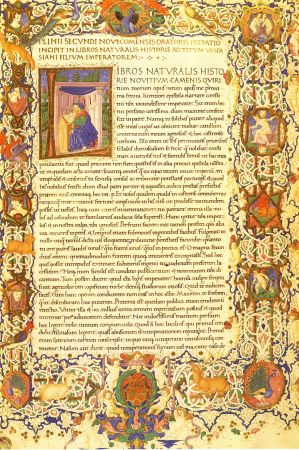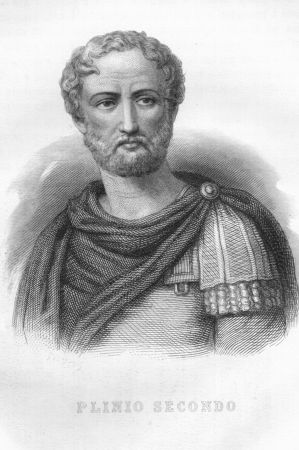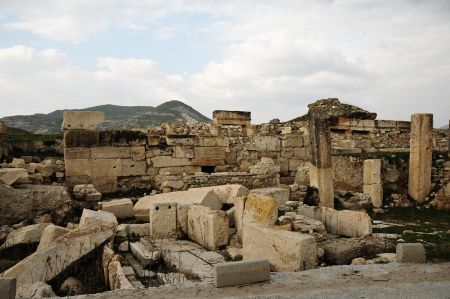Tripoli - mighty city destroyed by earthquake
- Written by Portal Editor
It was pure curiosity that made us follow the sign pointing to the ancient city of Tripoli. Coming from Izmir, we were still about 21 kilometers from Denizli when this street sign made us curious and, as so often, the decision was made quickly.
In the direction of Buldan, we turned left onto road 585, followed it for about 16 kilometers and then turned right to Yenicekent. We passed an apparently lifeless place that seemed cut off from the environment and forgotten, at least not a soul met us. So it was not surprising that we could not find Tripoli at first. The reason for this had been the heavy rains of the last few days, which had washed out part of the slope, so that we had followed the wrong route. As a tip for you: Keeping left from Yenicekent, it is just about 800 meters on a dirt road to the ruined city of Tripoli. Another 800 meters and you are standing on the banks of the Great Meander (Büyük Menderes Nehri).
Tripoli - neighbouring towns with Hierapolis and Laodikeia
 Today, the hilly landscape overlooking the river plain is absolutely bare and appears almost like a steppe landscape that must have once flourished, as other ancient cities attest. It is just 30 kilometers to Laodikeia in the Çürüksu valley and just 20 kilometers to Hierapolis, also known as Pamukkale because of the lime sinter terraces located there. The location of the city of Tripoli as a trading center on the Büyük Menderes and the associated valley opening to the west to the Aegean coast and to the east, following the course of the meandering river in the direction of Central Anatolia, shows the former importance of the city as a border, trade and agricultural center of the Region of Lydia combined with the ancient regions of Caria and Phrygia. Tripoli must once have been a rich city.
Today, the hilly landscape overlooking the river plain is absolutely bare and appears almost like a steppe landscape that must have once flourished, as other ancient cities attest. It is just 30 kilometers to Laodikeia in the Çürüksu valley and just 20 kilometers to Hierapolis, also known as Pamukkale because of the lime sinter terraces located there. The location of the city of Tripoli as a trading center on the Büyük Menderes and the associated valley opening to the west to the Aegean coast and to the east, following the course of the meandering river in the direction of Central Anatolia, shows the former importance of the city as a border, trade and agricultural center of the Region of Lydia combined with the ancient regions of Caria and Phrygia. Tripoli must once have been a rich city.
Since there have been few excavations to date, the question of who founded the city has so far been based on assumptions. The city was probably founded by Lydians. On the tour of the site, however, one comes across ruins, mostly of Roman or Byzantine origin, which probably date from the first to the third century AD. The ruins of a theater building can be found in the center of the city, which must have seated about 10,000 spectators in terms of size. Almost all areas show major decay, which clearly points to earthquakes as the cause. Just about 200 meters west of the theater, but outside the city walls, are the remains of a Roman bath. Unfortunately, most of the arch constructions have also collapsed, but some of the outer walls with large niches are still so well preserved that one can easily imagine the complexity of the building. Another public building can be identified by the basic structure a further 150 meters from the bath, perhaps once in the function of Tripoli's city hall.
Tripoli had to survive several earthquakes
 The city of Tripoli was expanded into a fortress in late Roman, perhaps already Byzantine times. Remains of the city walls and the castle complex clearly indicate this. A large number of fortress towers and observation towers can still be seen in the course of the city wall on the immense foundations. It is probable that parts of the city of Tripoli had already been destroyed before the fortified towers and city walls were erected and were not rebuilt. The theater is part of the city fortifications while the baths are outside.
The city of Tripoli was expanded into a fortress in late Roman, perhaps already Byzantine times. Remains of the city walls and the castle complex clearly indicate this. A large number of fortress towers and observation towers can still be seen in the course of the city wall on the immense foundations. It is probable that parts of the city of Tripoli had already been destroyed before the fortified towers and city walls were erected and were not rebuilt. The theater is part of the city fortifications while the baths are outside.
On the eastern and southern edges of the city wall are the necropolises of Tripoli, which, in addition to rock tombs and tombs on podiums, also show sarcophagi. Coins found here show the name of the goddess Leto, the contest of Letoia Phythia and motifs of the Great Meander.
From the tales of the historian Pliny, Tripoli had to survive several earthquakes and wars. He also mentions the name Apollonia, as Tripoli was called at times. In the list of the bishops of Lydia, which was handed over in the form of an enumeration to the bishops present during the assembly, today we would call it a conference, in 325 AD in Nikea, Tripoli is expressly mentioned as an important city.
Surely a large number of other fragments could be found if the search were to be continued. We had a special encounter ahead of us! As we marched back towards the dirt road back to the car, we were suddenly blocked by three mighty Kangal Shepherd Dogs, who were probably as surprised by our appearance as we were by them. A little further away we also saw the herd of sheep and goats that they had to guard. But more on that later.
Please read as well:
Eber Gölü - swampland and bird paradise again
İzmir: Pearl with palm trees - Turkish gateway to the Aegean
-
 Tripoli next to Denizli and Pamukkale
Tripoli next to Denizli and Pamukkale
Tripoli next to Denizli and Pamukkale
Tripoli next to Denizli and Pamukkale
-
 Tripoli next to Denizli and Pamukkale
Tripoli next to Denizli and Pamukkale
Tripoli next to Denizli and Pamukkale
Tripoli next to Denizli and Pamukkale
-
 Tripoli next to Denizli and Pamukkale
Tripoli next to Denizli and Pamukkale
Tripoli next to Denizli and Pamukkale
Tripoli next to Denizli and Pamukkale
-
 Tripoli next to Denizli and Pamukkale
Tripoli next to Denizli and Pamukkale
Tripoli next to Denizli and Pamukkale
Tripoli next to Denizli and Pamukkale
-
 Tripoli next to Denizli and Pamukkale
Tripoli next to Denizli and Pamukkale
Tripoli next to Denizli and Pamukkale
Tripoli next to Denizli and Pamukkale
-
 Tripoli next to Denizli and Pamukkale
Tripoli next to Denizli and Pamukkale
Tripoli next to Denizli and Pamukkale
Tripoli next to Denizli and Pamukkale
-
 Tripoli next to Denizli and Pamukkale
Tripoli next to Denizli and Pamukkale
Tripoli next to Denizli and Pamukkale
Tripoli next to Denizli and Pamukkale
-
 Tripoli next to Denizli and Pamukkale
Tripoli next to Denizli and Pamukkale
Tripoli next to Denizli and Pamukkale
Tripoli next to Denizli and Pamukkale
-
 Tripoli next to Denizli and Pamukkale
Tripoli next to Denizli and Pamukkale
Tripoli next to Denizli and Pamukkale
Tripoli next to Denizli and Pamukkale
-
 Tripoli next to Denizli and Pamukkale
Tripoli next to Denizli and Pamukkale
Tripoli next to Denizli and Pamukkale
Tripoli next to Denizli and Pamukkale
-
 Tripoli next to Denizli and Pamukkale
Tripoli next to Denizli and Pamukkale
Tripoli next to Denizli and Pamukkale
Tripoli next to Denizli and Pamukkale
-
 Tripoli next to Denizli and Pamukkale
Tripoli next to Denizli and Pamukkale
Tripoli next to Denizli and Pamukkale
Tripoli next to Denizli and Pamukkale
https://www.alaturka.info/en/turkey-country/aegean/5520-tripoli-mighty-city-destroyed-by-earthquake#sigProId6f313c0b86

